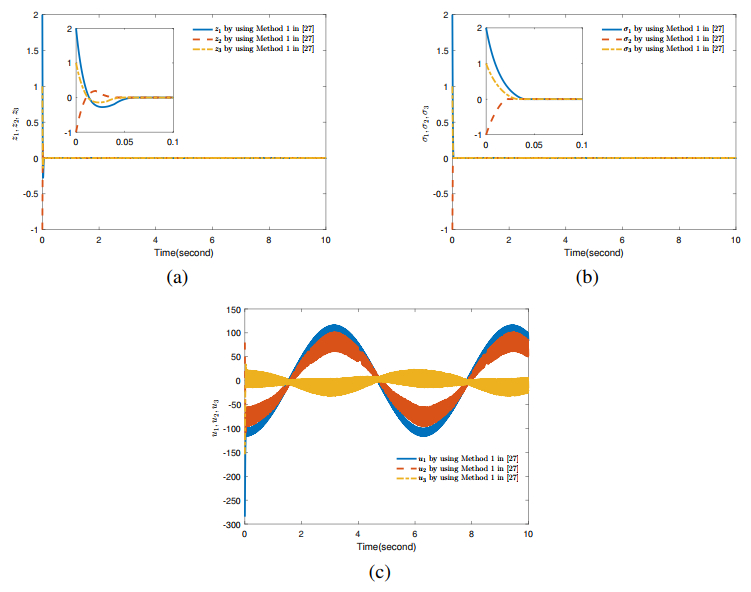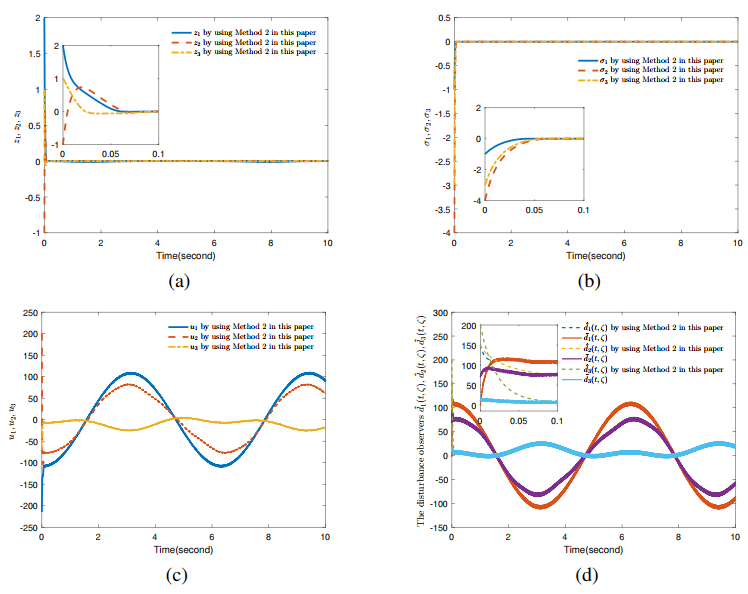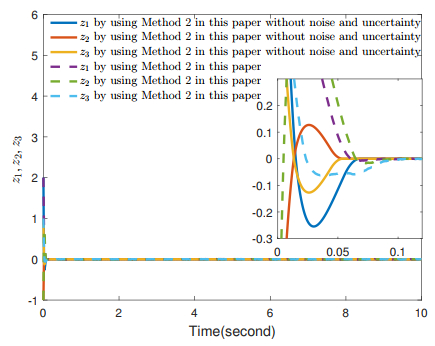1.
Introduction
Chaos refers to the irregular motion that occurs in a deterministic system, which is characterized by extremely sensitive initial conditions, inherent randomness, complexity and unpredictability. In chaotic systems (CSs), when the initial states of identical oscillators change slightly, their future states are usually different [1]. Pecora and Carol achieved outstanding research results in 1990 [2], and since then chaos synchronization has become a research hotspot, drawing wide heed from scientists, and being widely used in many fields of secure communication, network synchronization and control engineering [3,4,5]. In [6], a sliding mode control (SMC) method was proposed to synchronize unified CSs. In [7], an improved global nonlinear integral SMC method was developed to synchronize CSs with external disturbances and internal uncertainties. In [8], an extended state observer was developed to synchronize CSs based on linear differential equations. It should be emphasized that the above synchronization error is asymptotically stable, that is, the synchronization time may be relatively long.
Many industrial processes have higher requirements for convergence time, so finite-time stability has been proposed by many scholars. Different from the asymptotic-time control, finite-time control ensures that the synchronization error converges to origin within a finite time, and has the characteristics of higher convergence accuracy and faster convergence rate, which is an important breakthrough. In [9], under finite-time control theory, Cai et al. were committed to actualizing generalized synchronization of fractional order CSs. In [10], an SMC method was proposed to design a controller to ensure that uncertain complex CSs can synchronize in a finite time under network transmission. In [11], Ao et al. utilized an impulsive control method to synchronize CSs in a predefined time. In [12], a synchronization controller was designed to ensure that two CSs with different dimensions can synchronize in a finite time. However, the finite-time control suffers from some issues, for instance, the settling time is subject to the initial conditions. The initial value is often unknown in practice and cannot be set arbitrarily, which greatly increases difficulty of minimizing the synchronization time. When it is arbitrarily large, the synchronization settling time may be arbitrarily large. Therefore, this restricts the practical usage of finite-time control, and to a certain extent, makes finite-time control lack practical significance in industrial production. To address this problem, the fixed-time control [13] is presented. It is characterized by a constant upper bound for settling time, which isn't affected by the initial conditions. For practical systems with convergence time accuracy requirements, this feature advances the practical usage of fixed-time control. In [14], a terminal SMC method was applied to actualize the fixed-time synchronization between two identical CSs. In [15], a control strategy which isn't the same as the present adaptive design methods was developed for researching the fixed-time tracking control in nonlinear systems. However, there are also two main problems with fixed-time control. For one thing, it needs to calculate the boundary of the settling time. For another thing, it is conservative for estimating the settling time.
To address the above issues, the predefined-time control is proposed, whose main advantage is that the convergence time is uninflunced by the initial conditions [16,17]. It not only saves a process, which is to calculate the boundary of settling time, but also adjusts the predefined-time parameters by changing the system parameters. In recent years, scholars have also made a lot of efforts on predefined-time synchronization (PTS) of CSs. In [18], a simplified control inputs method was developed to achieve PTS of memristor CSs. In [19], under predefined-time stability theory, a control method was presented to realize the PTS of CSs. In [20], by designing a synchronization controller, PTS of a chaotic system at different dimensions was successfully achieved. It should be noted that the model of the aforementioned chaotic system should be known in advance.
It is well known that SMC is an effective nonlinear control method for uncertain systems due to its anti-interference ability and robustness. There are also some related works [21,22,23,24,25,26,27] on PTS of CSs using SMC. In [21], under the PTS theory, a novel fast terminal SMC scheme was developed to synchronize two different multi-input and multi-output CSs. An active controller was developed to ensure that two CSs achieved PTS, where a new sliding surface was designed in [22]. In [23], aming to achieve fast and accurate synchronization of CSs within a predefined time, an SMC method was proposed. In [24], Zhang et al. presented an SMC method to achieve PTS of CSs, where a sliding mode synchronization controller was developed to guarantee that the dynamic system is capable of reaching the sliding surface within a predefined time; however, its sliding surface is relatively complex, and the shaking phenomenon is obvious. Therefore, further research is needed on how to design a simple and practical sliding surface to track and control CSs within a predefined time.
Based on the above discussion, there are three points that need to be further explored regarding the control of CSs : 1) These references have a hypothesis that the upper bounds of external disturbances and internal uncertainties are known, but may be unknown in practice. How to design a predefined-time control for CSs under these unknown conditions has become a research focus. 2) If the internal uncertainty and external disturbances of the system are regarded as a mixed disturbance, the design of disturbance observer becomes necessary. 3) Due to the use of the sliding mode control method, further research is needed on how to reduce the chattering phenomenon of the sliding mode controller.
Recently, significant research results have been obtained on optimal control of nonlinear systems [28,29,30,31], For example, in [28], an output feedback algebraic Riccati equation was constructed to design an output feedback optimal control strategy for nonlinear systems. A hybrid hierarchical classification algorithm was proposed in [30]. Therefore, based on the above work on the design of observer and adaptive law, the main contributions of this article are as follows: (I) Develop a disturbance observer that can effectively estimate the mixed disturbance. (II) A new sliding surface is presented, and it enables the tracking error to reach a small neighborhood of zero at the origin within a predefined time when the tracking error runs on it. (III) The chattering phenomenon of the controller is greatly reduced. The remaining of this article is arranged following. Section 2 introduces preliminaries and problem descriptions. The development of sliding surface and controller are included in Section 3. Examples in Section 4 are provided to verify the efficiency of the presented method. Conclusions are provided in Section 5.
2.
Preliminaries and system description
Consider the following n-dimensional CSs
where ζ=[ζ1,ζ2,⋅⋅⋅,ζn]T∈Rn is measurable system state. gi(ζ):Rn→R is the continuous nonlinear function, Δgi(ζ):Rn→R is the internal uncertainty and di:R→R is the external disturbance. u=[u1,u2,⋯,un]T∈Rn is the control input vector.
Assumption 1. Assume that the continuous nonlinear function gi(ζ), the internal uncertainty Δgi(ζ) and the external disturbance di are unknown and bounded, i=1,2,⋅⋅⋅,n.
Remark 1. In [22,23,24,25,26,27], the internal uncertainty Δgi(ζ) satisfies |Δgi(ζ)|≤φi‖ζ‖, and the external disturbance di satisfies |di|≤Ci. The nonlinear continuous function gi(ζ) and positive constants φi and Ci are known. In contrast, this paper only assumes that gi(ζ), Δgi(ζ) and di are bounded. Based on this condition, we will design the disturbance observer ˆdi(t,ζ) to estimate gi(ζ)+Δgi(ζ)+di.
Define xd=[xd1,xd2,⋅⋅⋅,xdn]T as the reference signal and the tracking error is defined as z=[z1,z2,⋅⋅⋅,zn]T=[ζ1−x1d,ζ2−x2d,⋅⋅⋅,ζn−xnd]T. The system (2.1) and the tracking error system can be written as
and
where ˉdi(t,ζ)=gi(ζ)+Δgi(ζ)+di.
Definition 1 (Finite time stability [32]). Assume that the sysnchronization error system (2.3) is asymptotically stable and any solution z(t,z0) reaches the equilibrium point in a finite time, i.e.,
then the error system (2.3) is a finite-time stability. T(z0) is the settling time, which depends on the initial value z0.
Definition 2. (Fixed time stability [33]). Assume that the error system (2.3) is globally finite-time stable. If the settling time T(z0) is bounded, namely, there is a constant Tmax>0 such that T(z0)≤Tmax for all z0∈Rn, then the error system (2.3) is a fixed-time stability.
Definition 3 (Predefined-time stability [34]). Assume that the error system (2.3) is globally fixed-time stable. If the settling time T(z0) satisfies T(z0)≤Tc for all z0, where Tc>0 is a predefined time, then the error system (2.3) is a predefined-time stability.
Remark 2. In contrast to finite-time stability, predefined-time stability is unaffected by initial conditions. It is superior than fixed-time stability because it can pre-allocate the boundary of the settling time, saving time in calculating the boundary of the settling time, making theoretical analysis simpler and estimating convergence time more accurately.
For the sake of better deterring whether a dynamic system is a predefined-time stability, the following conclusion needs to be used in this article.
Lemma 1 ([35]). If the system ˙ς=ϕ(t,ς) is a finite-time stability and a Lyapunov function V(t) satisfies
then ˙ς=ϕ(t,ς) is a predefined-time stability, where Tc> 0 is a predefined time and q∈(0,12).
Proof. The settling time implies that V(t) with an initial value V0>0 converges to Vf=0 in the time T(ς0). From (2.5), one obtains
Notice that ˙ς=ϕ(t,ς) is finite-time stability and the settling time T(ς0)≤ Tc. Therefore, ˙ς=ϕ(t,ς) is a predefined-time stability. This completes the proof. ■
Lemma 2 ([36]). If a Lyapunov function V(t) satisfies
where r>0, then for a given positive constant υ≜ that satisfies for all , where is a predefined time and .
Lemma 3 ([36]). If function is continuous on a compact , then can be expressed as
where is the ideal parameter vector, is the fuzzy basis function vector, is the fuzzy estimation error such that , where is an unknown positive constant.
3.
Design of predefined-time control scheme
3.1. Design of the disturbance observer
In order to estimate the unknown function , the following observer is designed:
where is a design positive parameter and is an estimate of ( by using Lemma 3). Define the estimation error . One has
Theorem 1. For the system (2.2), the observer error is bounded by using the disturbance observer in (3.1) and the adaptive law as
where are positive constants.
Proof. Consider Lyapunov function , where . Form (3.1) and (2.7), one has
Let . Select such as and define the following compact sets: and . Obviously, if or , one has . Thus, and are bounded. When and are limited within the small compact sets and , respectively, then is also bounded, that is, there exists a positive constant such that . This completes the proof. ■
3.2. Design of the sliding surface and controller
The design idea of this article is divided into two steps: The first step is to design a sliding manifold so that the tracking error can reach the neighborhood of zero on the sliding surface within a predefined time. The second step is to design a controller so that the error system can reach the sliding surface within a predefined time.
In this article, the sliding manifold and the corresponding controller are designed as follows:
and
where are predefined times and .
The following theorem states the primary result.
Theorem 2. If the controller is chosen as (3.6), then the synchronization system (2.3) will reach the sliding surface within the predefined time .
Proof. Select a Lyapunov function as , then
Notice that . One gets
By using Lemma 1, the tracking system (2.3) will reach the sliding surface within the predefined time . This completes the proof.■
When the tracking error system (2.3) is limited on the sliding surface , one has , that is
From (3.9), the sliding surface can guarantee that when the error system (2.3) runs on it, the tracking error is stable within . The following theorem is given as below.
Theorem 3. If the tracking error system (2.3) runs on the sliding surface , then the tracking error will converge to the neighborhood of zero within the predefined time .
Proof. According to (3.9), if the tracking error system (2.3) moves on the sliding surface after , one has , so
Let , then one has
By using Lemma 2, one has within , that is, , . Thus, the proof of Theorem 3 is complete.■
Remark 3. According to the results of Theorem 1–3, it can be concluded that the tracking error will approach after the predefined time .
Remark 4. In [24], a sliding surface was designed as , in which , , , , . Compared with the sliding manifold designed in [24], the proposed sliding manifold (3.5) consists of an integral term and auxiliary variables, which can ensure robustness and avoid the drawbacks of the common sliding mode approach stage by finding an appropriate initial position to make the system only have a sliding stage.
4.
Numerical simulation
To demonstrate the effectiveness of the proposed method, The Lü system [37] is used as a simulation example to illustrate. The Lü system is described as
where the initial values of the system (4.1) are . When , and , the phase diagrams of the Lü system are illustrated in Figure 1. The internal uncertainties are , , and . , , are uniformly randomly distributed noise with amplitudes of 3.5.
In this section, we compare our proposed method with the method in [27]. The reference signal is .
It should be emphasized that the method in [27] assumes that is known and that and satisfy the following inequalities: and , where and are known positive constants, .
Method 1: The predefined-time SMC method in [27] employs (4.2) as the sliding manifold and (4.3) as the controller.
All parameters in Method 1 are selected as , , , , , , , , , . Simulation results of Method 1 are depicted in Figure 2.
Obviously, Figure 2 shows that Method 1 in [27] can achieve that tracking errors and approach the origin within the predefined 0.2 seconds. However, there are two points that need improvement: 1) The nonlinear function and two upper bounds and may be unknown rather than known. If , and are regarded as the mixed disturbance , a disturbance observer needs to be designed to estimate effectively; 2) the chattering phenomenon of the controllers and needs to alleviate. To improve the above two issues, the proposed control method in this article is as follows:
Method 2: The predefined-time control method in this paper uses (3.1) as the disturbance observer, (3.5) as the sliding surface, and (3.6) as the controller. For and , five fuzzy sets are defined over [5, 5] with partitioning points as 5; 2.5; 0; 2.5; 5. Define the vectors as and , . The fuzzy membership functions are given as , , . We can express , and as , where . The parameters and remain the same as those in Method 1. In addition, other parameters are selected as , . Initial values are selected as , . Simulation results of Method 2 are depicted in Figure 3. As shown in Figure 3, the proposed Method 2 can overcome the influence of unknown mixed disturbances , and and ensure that tracking errors and approach the neighborhood near the origin within 0.3 seconds, and the chattering phenomenon of controllers and is greatly reduced. Meanwhile, the designed disturbance observers , and can effectively estimate the corresponding mixed disturbances , and . Therefore, one can conclude that the presented method has better performance.
4.1. Robustness test
This part verifies the anti-interference ability and robustness of the presented approach, and analyzes it in the absence or presence of random disturbance noise and uncertainty. When the system (2.1) is not affected by the random noise disturbance and internal system uncertainty, and nonlinear functions , and are known, the sliding mode manifold and controller design of Method 2 in this paper are as follows:
and
Select the initial value and control parameters as the same as the previous ones. The simulation result is shown in Figure 4.
Figure 4 shows that the proposed method has good anti-interference and robustness in the presence of noise and internal system uncertainty.
5.
Conclusions
This article presents a predefined-time SMC strategy for tracking -dimensional CSs under uncertainties and disturbances. First, a disturbance observer and a novel sliding manifold are derived. Second, a sliding mode controller is developed for CSs. The predefined time is not affected by the initial conditions and can be set arbitrarily according to actual needs. The main difference from fixed-time control is that it can pre-allocate convergence time, so that the proposed method can meet the practical requirements of predefined convergence time even in the presence of internal uncertainties and random noise disturbances. The simulation results confirm the effectiveness and robustness of the method proposed in this paper.
Use of AI tools declaration
The authors declare they have not used Artificial Intelligence (AI) tools in the creation of this article.
Acknowledgments
This work was supported in part by Anhui province university excellent talents funding project (gxbjZD2021075) and in part by the Natural Science Foundation for the Higher Education Institutions of Anhui Province (2023AH051549).
Conflict of interest
The authors declare there is no conflict of interest.










 DownLoad:
DownLoad:






